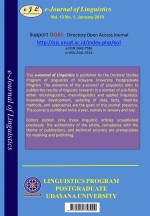Falia‘s Ke-kaghati-an in Muna Speech Community From the Ecolinguistic Perspective
Abstract
This paper explained falia ‘taboo’ in kaghati in the Muna Speech Community (MSC) from the ecolinguistic perspective. The kite ‘kaghati’ is one type of the traditional games and a tribal cultural product in MSC which still exists and remains maintained. The forms of interaction, interrelation, and the interdependence in MSC with the natural and socio-cultural environments are recorded in falia’s ke-kaghati-an.The problem in this paper is to answer the question what expression in falia’s ke-kaghati-an is used to express environment in MSC. The purpose of this paper is to describe and analyze the falia expressions found in ke-kaghati-an’s environment. This research is classified as a qualitative descriptive study as it describes the phenomena of falia expressions and environmental knowledge, especially the ones currently used in ke-kaghati-an’s environment, and the source of natural data as a manifestation of the Muna's socio-cultural-ecological life.
Falia’s ke-kaghati-an is such a magical expression of magical value that MSC, especially the kaghati maker, feels afraid of breaking it.The expression of falia’s ke-kaghati-an teaches the belief in God, gratitude, balance of life, discipline, justice, honesty, orderliness, beauty, tolerance, and mutual respect. Falia is one way in which MSC shows their adherence to the local wisdom values, especially with regard to the environmental conservation that has been inherited from the ancestors since a long time ago. Conservation of the wealth of the expression of falia in MSC is very important, for both the sustainability of the Muna language and the conservation of kaghati with its traditions and culture, which is preserved in the meaning and cultural values ??of the past heritage as part of itspersonal identity, especially for the younger generation.
Downloads
References
Date accessed: 09 oct. 2018.
Bang, J and Døør, J. 2000. Ecology, Ethics & Communication, Dialectical Ecolinguistics: Edited by: Anna VibekeLindø and JeppeBundsgaard, (53-84). University of Odense, Denmark.
Berg, Rene van Den dan La Ode Sidu Marafad. 2013. Kamus Muna-Indonesia. Cetakan Pertama, Yogyakarta: PustakaPuitika.
Black, James A. Dean J. Champion1992.MetodedanMasalahPenelitianSosial. Penerjemah: E. Koeswara, DiraSalam, AlfinRushendi. Bandung: Eresco.
Bundsgaard, J and Steffensen, S. 2000. The Dialectics of Ecological Morphology or the Morphology of Dialects. Dialectical Ecolinguistics: Edited by: Anna VibekeLindø and JeppeBundsgaard, (8-36). University of Odense, Denmark.
Daeng, Hans J. 2000. Manusia, Kebudayaan, dan Lingkungan. Yogyakarta: Pustaka Pelajar.
Fill, A and Peter Mühlhaüsler (eds). 2001. The Ecolinguistics Reader: Language, Ecology, and Environment. London and New York: Continuum.
Halliday, M.A.K. 2001. New ways of Meaning: The Challenge to Applied Linguistics, The Ecolinguistic Reader: Language, Ecology, and Environment. Edited by Alwin Fill and Peter Mühlhaüsler (175-202). New York: Continuum.
Haugen, Einar. 1972. The Ecology of Language. Stanford, CA: Stanford University Press.
Lindø, Anna Vibeke and Jeppe Bundsgaard (eds). 2000. Dialectical Ecolinguistics: Three Essays for the Symposium 30 years of Language and Ecology. Odense: University of Odense.
Marafad, La Ode Sidu dan La Niampe. 2017. Model Buku Ajar Ungkapan Falia sebagai Materi Pendidikan Karakter Siswa SD di Kabupaten Muna, Sulawesi Tenggara. Yogyakarta: Penerbit Pustaka Puitika.
Mbete, Aron Meko. 2002. “Ungkapan-Ungkapan dalam Bahasa Lio dan Fungsinya dalam Melestarikan Lingkungan.” Linguistika. Volume 9, No. 17. Denpasar.
Mbete, Aron Meko. 2009. “Refleksi Ringan tentang Problematika Keetnikan dan Kebahasaan dalam Perspektif Ekolinguistik.” Makalah Seminar Budaya Etnik III. Medan: USU.
Odum, Eugene P. 1996. Dasar-Dasar Ekologi. Yogyakarta: Gadjah Mada University Press.
RAMBUT, Kanisius et al. ECOLINGUISTIC PERSPECTIVE OF KERAPINGAN CULTURE. e-Journal of Linguistics, [S.l.], p. 40--53, oct. 2015. ISSN 2442-7586. Available at:
Sapir, Edward. 1912. Language and Environment. American Anthropologist New Series, Vol. 14, No. 2 (Apr-Jun, 1912), pp. 226-242.

This work is licensed under a Creative Commons Attribution 4.0 International License.

This work is licensed under a Creative Commons Attribution 4.0 International License











